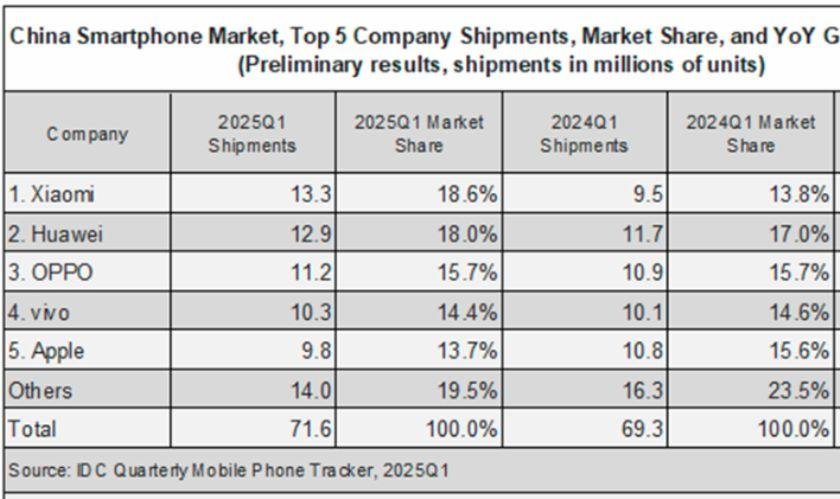The leaders in China’s smartphone market in Q1 2025 are Xiaomi (18.6 percent share), Huawei (18 percent share), OPPO (15.7 percent), Vivo (14.4 percent) and Apple (13.7 percent).

China’s smartphone market has recorded shipments of 71.6 million units in the first quarter of 2025, reflecting a 3.3 percent year-on-year (YoY) increase, according to data from the International Data Corporation (IDC) Worldwide Quarterly Mobile Phone Tracker.
The growth in the smartphone market in China was primarily driven by government subsidies introduced in January 2025 and the seasonal sales surge during the Spring Festival. However, the impact of the subsidies on boosting consumer demand was described as modest due to the limited scale of the incentives and a complex rollout process.
Leading brands in China
Xiaomi led the market with 13.3 million units shipped and an 18.6 percent market share, a notable rise from 9.5 million units and 13.8 percent share last year.
Huawei followed closely with 12.9 million shipments and an 18.0 percent share, up from 11.7 million units and 17.0 percent share.
OPPO maintained its market share at 15.7 percent with 11.2 million units, a slight increase from 10.9 million.
Vivo shipped 10.3 million units for a 14.4 percent share, nearly flat from 10.1 million and 14.6 percent previously.
Apple experienced a decline, dropping to 9.8 million units and a 13.7 percent share from 10.8 million units and 15.6 percent.
The “Others” category saw a decline in both shipments and share, falling to 14.0 million units and 19.5 percent from 16.3 million units and 23.5 percent a year earlier.
Trends
Despite rising US-China tensions casting a shadow over the economy, the first quarter’s growth gave the industry a slightly more favorable position to navigate potential challenges later in the year. Will Wong, senior research manager for Client Devices at IDC Asia/Pacific, noted that while geopolitical issues have fueled uncertainty, the positive performance in Q1 offers some resilience for market players.
He also highlighted Xiaomi’s return to the top position in the Chinese market for the first time in nearly a decade, attributing its resurgence to effective targeting of price-sensitive consumers who benefited most from the subsidies. In contrast, Apple saw a decline, largely due to its premium pricing strategy, which limited its ability to leverage government support.
Arthur Guo, senior research analyst at IDC China, emphasized that Q1 2025 marks the sixth consecutive quarter of growth for China’s smartphone market. Still, he cautioned that the subsidy program’s effectiveness was hindered by its limited appeal and administrative hurdles.
Looking forward, the market is expected to face mounting challenges, including cost pressures and shrinking consumer budgets stemming from ongoing trade tensions between the US and China.
Meanwhile, global smartphone shipments rose 1.5 percent YoY to 304.9 million units in Q1 2025, according to IDC. Anticipating U.S. tariff hikes on Chinese imports, vendors accelerated production and shipments, particularly to the U.S. The U.S. market grew over 5 percent, driven by strong interest in new models and urgency to purchase ahead of possible price hikes.
Baburajan Kizhakedath
